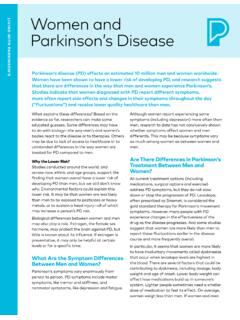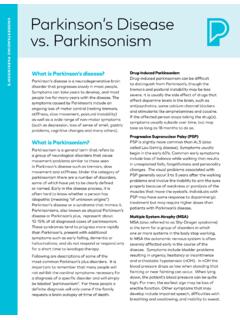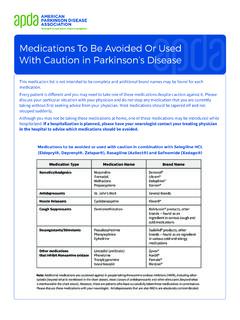Transcription of Parkinson’s Disease: Diagnosis and Treatment
1 parkinson 's disease : Diagnosis and Treatment SHOBHA S. RAO, , LAURA A. HOFMANN, , and AMER SHAKIL, , University of Texas Southwestern Medical School at Dallas Family Medicine Residency Program, Dallas, Texas parkinson 's disease is a common neurodegenerative disorder that can cause significant disability and decreased quality of life. The cardinal physical signs of the disease are distal resting tremor, rigidity, bradykinesia, and asym- metric onset. Levodopa is the primary Treatment for parkinson 's disease ; however, its long-term use is limited by motor complications and drug-induced dyskinesia. Dopamine agonists are options for initial Treatment and have been shown to delay the onset of motor complications. However, dopamine agonists are inferior to levodopa in controlling motor symptoms. After levodopa-related motor complications develop in advanced parkinson 's disease , it is beneficial to initiate adjuvant therapy with dopamine agonists, catechol O-methyltransferase inhibitors, or monoamine oxidase-B inhibitors.
2 Deep brain stimu- lation of the subthalamic nucleus has been shown to ameliorate symptoms in patients with advanced disease . Depression, dementia, and psychosis are common psychiatric problems associated with ILLUSTRATION BY TERI J. MCDERMOTT. parkinson 's disease . Psychosis is usually drug induced and can be managed initially by reducing antiparkinsonian medications. The judicious use of psychoactive agents may be necessary. Consulta- tion with a subspecialist is often required. (Am Fam Physician 2006;74:2046-54, 2055-6. Copyright 2006 American Academy of Family Physicians.). P. Diagnosis . Patient information: arkinson's disease is a progres- A handout on parkinson 's disease , written by the sive neurodegenerative disorder Despite advances in radiologic testing, the authors of this article, is with an estimated prevalence of Diagnosis of idiopathic parkinson 's disease provided on page 2055. percent in the remains a clinical one.
3 A Diagnosis requires The prevalence increases to 4 to 5 percent the presence of the following cardinal signs: in those older than 85 Characteris- distal resting tremor of 3 to 6 Hz, rigid- tic neuropathologic features of the disease ity, bradykinesia, and asymmetrical are dopaminergic neuron degeneration in Other well-known signs of parkinson 's dis- the substantia nigra and the presence of ease include late-onset postural instabil- eosinophilic intracytoplasmic inclusions ity, decreased olfaction, and micrographia. (Lewy bodies) in the residual dopaminergic Patients must also respond to an adequate Family physicians should have therapeutic challenge of levodopa or a dopa- a good understanding of parkinson 's dis- mine Symptoms and signs associ- ease because of its increasing prevalence as ated with parkinson 's disease are summarized the population ages. Treatment should be in Table individualized to decrease symptoms while The clinical presentation of parkinson 's minimizing motor and nonmotor complica- disease is similar to that of diverse neu- tions (Figure 1).
4 3,4 As the disease progresses, rologic disorders called parkinsonisms Treatment can be increasingly complicated, (Table 2).5-8 Symptoms that suggest a diag- and comanagement with a subspecialist may nosis other than parkinson 's disease include be required. The most important goal is to lack of response to levodopa, hallucinations, help patients maintain maximal autonomy prominent and early dementia, early pos- and quality of life. tural instability, severe and early autonomic . Downloaded from the American Family Physician Web site at Copyright 2006 American Academy of Family Physicians. For the private, noncommercial use of one individual user of the Web site. All other rights reserved. Contact for copyright questions and/or permission requests. SORT: KEY RECOMMENDATIONS FOR PRACTICE. Evidence Clinical recommendation rating References Levodopa is the most effective pharmacologic Treatment for parkinson 's disease symptoms, A 14, 15.
5 Especially bradykinesia and rigidity. Dopamine agonists effectively treat early parkinson 's disease . A 15, 17-19, 21, 24, 25. Motor complications in patients with advanced parkinson 's disease can be treated by adding a A 15, 24-27. dopamine agonist, monoamine oxidase-B inhibitor, or catechol O-methyltransferase inhibitor to levodopa therapy. Deep brain stimulation of the subthalamic nucleus can improve parkinson 's disease symptoms. A 15. A = consistent, good-quality patient-oriented evidence; B = inconsistent or limited-quality patient-oriented evidence; C = consensus, disease - oriented evidence, usual practice, expert opinion, or case series. For information about the SORT evidence rating system, see page 2008 or Diagnosis and Management of parkinson 's disease Patient presents with signs and symptoms consistent with parkinsonism Idiopathic parkinson 's disease confirmed (Table 1). Yes No Consider CT or MRI to rule out normal No functional impairment pressure hydrocephalus or a vascular cause; consider referral to a subspecialist.
6 Monitor for disease progression. disease progresses Functional impairment present Consider immediate-release carbidopa/. levodopa (Sinemet) or a dopamine agonist. Continued disease progression Increase immediate-release carbidopa/levodopa dose or increase dopamine agonist to the maximum tolerated dose, then add carbidopa/levodopa. Motor complications develop Fractionate carbidopa/levodopa therapy five times a day, and consider adding a dopamine agonist, MAO-B inhibitor, or COMT inhibitor. Severe motor fluctuations Consider referral for apomorphine (Apokyn) therapy. Severe dyskinesia No improvement Reduce carbidopa/levodopa dose; if patient is taking No improvement Refer for possible functional neurosurgery. controlled-release preparation, change to immediate- release; consider amantadine (Symmetrel). Figure 1. Algorithm for the Diagnosis and management of parkinson 's disease . (CT = computed tomography;. MRI = magnetic resonance imaging; MAO-B = monoamine oxidase-B; COMT = catechol O-methyltransferase.)
7 Information from references 3 and 4. December 15, 2006 Volume 74, Number 12 American Family Physician 2047. parkinson 's disease dysfunction, upward gaze paralysis, and involuntary progression. Preliminary studies suggest that coenzyme movements other than Q1010 and some dopamine agonists11,12 may slow disease Advances in radiologic technologies have aided in progression. Despite these studies, no neuroprotective distinguishing the etiologies of parkinsonism and in agents have been proven effective. more accurately diagnosing idiopathic parkinson 's dis- ease. Although head computed tomography (CT) and Symptom Management magnetic resonance imaging (MRI) show no specific Symptomatic therapy for parkinson 's disease should parkinson 's disease patterns, they can help rule out be initiated at the onset of functional impairment. Sev- or confirm other diseases. Rapidly emerging tech- eral factors determine whether a patient has functional nologies ( , positron emission tomography, single- impairment.)
8 For instance, involvement of the dominant photon emission CT) likely will impact parkinson 's hand and bradykinesia tend to most greatly affect a disease diagnoses; however, the evidence currently does patient's ability to work and perform activities of daily not show that specific tests improve diagnostic accu- The Unified parkinson 's disease Rating Scale New data suggest that pronounced loss of olfac- (UPDRS) is a standardized assessment tool that facili- tion can distinguish parkinson 's disease from other tates accurate documentation of disease progression and Treatment The four-part scale measures mental effects, limitations in activities of daily living, Neuroprotection motor impairment, and Treatment or disease compli- Neuroprotection includes secondary prevention strate- cations. The UPDRS is available at gies aimed at slowing, blocking, or reversing disease org/ Table 1. Signs and Symptoms of parkinson 's disease Sign/symptom PPV NPV Description History of tremor to 17 to Observed as patient rests hands in his or her lap; often described as pill- Distal resting tremor as a sign to to rolling in quality; must be distinguished from postural tremor (as limb is held against gravity) or kinetic tremor (occurs with movements).
9 History of bradykinesia and Difficulty with rapidly and sequentially tapping the fingers of one rigidity hand and then the other on a table top; difficulty tapping the Difficulty turning over in bed 13 heel rapidly; difficulty twiddling or circling the hands rapidly Difficulty opening jars around each other in front of the body; reduced arm swing on affected side during ambulation Difficulty rising from a chair to to Rigidity as a sign to to The physician feels resistance as he or she places a finger within the patient's antecubital fossa and repeatedly flexes and extends the patient's arm at the elbow; resistance can be cogwheel rigidity (catching and releasing) or lead-pipe rigidity (continuously rigid);. rigidity must be distinguished from spasticity, which has only increased flexor tone; rigidity also can be tested at wrist supination or pronation Poor heel-to-toe gait Small, shuffling steps may be observed, with difficulty initiating History of shuffling gait to 15 to ambulation; patients may have a festinating gait (involuntary Loss of balance to to acceleration of gait); heel-to-toe ambulation is impaired; arms often are stationary; posture often is stooped; patients may have difficulty turning and have poor balance History of micrographia to to Handwriting is small and often indecipherable PPV = positive predictive value; NPV = negative predictive value.
10 Adapted with permission from Rao G, Fisch L, Srinivasan S, D'Amico F, Okada T, Eaton C, et al. Does this patient have parkinson 's disease ? JAMA. 2003;289:251. 2048 American Family Physician Volume 74, Number 12 December 15, 2006 . Table 2. Differential Diagnosis of Parkinsonism Diagnosis Historical features Signs/symptoms Radiographic finding Comments Idiopathic parkinson 's Difficulty with tasks, See Table 1 No specific CT or MRI . disease rigidity, tremor findings Drug-induced Previous use of a Tremor, rigidity, bradykinesia; Normal May persist for up parkinsonism causative drug such often bilateral symptoms to one year after as an antipsychotic, discontinuation of reserpine (Serpalan), the drug or metoclopramide (Reglan). Vascular parkinsonism Stepwise progression; Fixed deficits from previous Lesions in white matter Common because CVA or TIA, comorbid events with or without basal of the prevalence cardiovascular disease ganglia5 of cerebrovascular disease5.















